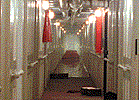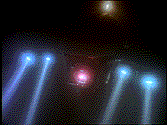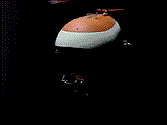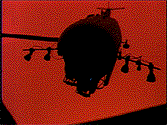|

Such digital tweaks not only fixed minor problems in the footage but also helped give rise to new editing decisions. A simple empty hallway shot--showing the handcuffed Jack's isolation below deck--originally had a wrinkled mylar blanket lying on the floor halfway down the hall, pretending to be a puddle of water.

|

What started as removing a mylar blanket from a simple hallway shot became a digital creeping water shot, courtesy of BFTR.
©1997 Paramount/Fox
|
|
Since this didn't prove particularly convincing, we were simply asked to paint out the blanket. Naturally, we accidentally created and tracked digital water into the shot, all in After Effects. Jim Cameron was so annoyed with us for doing so that he recut the scene to feature the water level rising... and thus the sequence received an additional layer of threat.
Such shenanigans of giving the director more than he asked for resulted in BFTR being awarded the compositing of the opening effects



Beauty smoke pass, fill light pass, matte pass: just three of the many layers of motion control miniature footage shot by Digital Domain and supplied to BFTR for compositing.
©1997 Paramount/Fox
|
shot in the film. Immediately following the main title is a 35-second shot showing the two MIR submersibles descending out of the darkness, falling past camera and then receding back into infinity. Although DD had spent the better part of a year shooting the motion control miniature sub elements for the shot, they were swamped with other hero shots, so BFTR came to their assistance.
The complexity of the shot was daunting, since the two subs were shot separately in multiple passes. There was a beauty pass with shafting lights, a fill light pass, a matte silhouette pass and a separate "stem" matte pass to hold out the miniature sub's support pylon. The beauty pass had been shot by DD on a dry set filled with smoke, and the long exposures needed to get the right look tended to burn out at least one or more of the ultra-bright projector lamps (they were designed to be cooled by a fan) used on the miniature. As a result, there was no single pass for the main element, but rather a series of barely-overlapping segments, between which bulbs were changed on the model. Each time a lamp burned out, ALL the lamps on the model had to be replaced to insure that all the lamps were at equal points of their life-expectancy.
In addition, the motion control stage was only so big, so both ends of the move needed to be created in the composite by continuing to shrink a hold frame of the subs into the distance. A layer of fine, floating particulate matter also needed to be created and added into the subs' light beams to add underwater realism.
Compounding these challenges was the fact that the shallow color gradients and subtle contrast in the shot necessitated that we work in 10-bit Cineon format, which we had not worked with up to this point; all of our other visual effects shots for all our films had been carefully and successfully achieved in 8-bit linear. With over 40 gigabytes of scans from DD and only six weeks to do the composite, both the production and DD were understandably concerned with our ability to pull the shot off. To tackle this challenge, we turned to a powerful command-line compositing program called Shake, from a small company called Nothing Real, which allowed us to not only composite and finesse the various elements but also add realistic film grain and color correct the image to Jim Cameron's trademark blue look.
Artists Brian Holden and Yukiko Ishiwata did paint tweaks and cleanup on the original motion control elements, painstakingly painting out the silhouette of the support pylon that was visible in the gradient of the beauty smoke pass, Steve Walker tracked and created 3D particulate matter on the Macintosh using Northern Lights' Dante plug-in for ElectricImage, and with the tireless help and dedication of Shake's programmer Arnaud Hervas, Van was able to learn the command-line-only program in a scant two weeks. We were able not only to make the delivery date, but to deliver the final approved shot several weeks early, in time for the Tokyo premiere.

BFTR composited the opening visual effects shot of the film, which involved not only cleaning up and putting together multiple elements from Digital Domain but creating a CG particulate matter pass in ElectricImage and extending the motion of DD's footage into infinity at both ends of the shot. To see larger images of this shot, as well as an abbreviated Quicktime movie of the 35-second shot, click here.
©1997 Paramount/Fox
|
Although we were the last and probably one of the smallest effects houses to be brought on to TITANIC, our work earned us fifth billing in the effects credits, behind only Digital Domain, VIFX, ILM and Cinesite, all big houses with whom we are proud to be listed. Jim Cameron's faith in our work was most gratifying of all: "These guys are using the digital tools exactly as they should be used... to help tell the story." continued...


Banned From The Ranch Entertainment Home Page
����General Information: info@bftr.com
|

